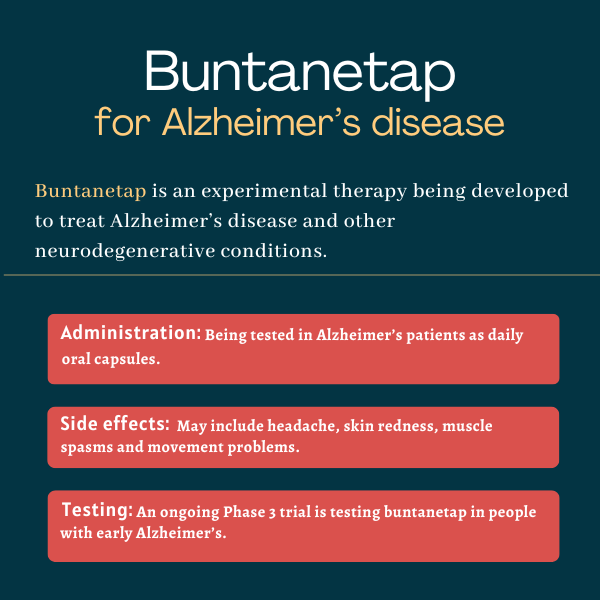Buntanetap for Alzheimer’s disease
Last updated April 3, 2025, by Lindsey Shapiro, PhD

What is buntanetap for Alzheimer’s disease?
Buntanetap, previously known as posiphen or ANVS401, is an oral small molecule being investigated as a possible treatment for Alzheimer’s disease.
It is being developed by Annovis Bio, which is also evaluating the therapy in certain other neurodegenerative conditions, including Parkinson’s disease and Lewy body dementia.
While current clinical trials in Alzheimer’s have evaluated buntanetap alone, Annovis is also looking into whether the therapy’s benefits may be enhanced when combined with Trulicity (dulaglutide), a type 2 diabetes medication, and/or the erectile dysfunction medication Viagra (sildenafil citrate).
Therapy snapshot
| Treatment name: | Buntanetap |
| Administration: | Taken as oral capsules |
| Clinical testing: | Being tested in a Phase 3 trial for Alzheimer’s disease |
How does buntanetap work?
In Alzheimer’s disease, certain proteins, particularly beta-amyloid and tau, accumulate to toxic levels and contribute to the nerve cell damage and dysfunction that drive cognitive decline and other Alzheimer’s symptoms.
Buntanetap is designed to reduce production of these neurotoxic proteins by blocking translation, the process by which cells use their genetic blueprints to make proteins.
To make a protein, the information in DNA is turned into a template molecule called messenger RNA (mRNA), which is then read by cells’ protein-making machinery during translation. Under normal conditions, producing neurotoxic proteins is inhibited because a protein called iron regulatory protein 1 (IRP1) binds to their mRNA and prevents translation. But in injured states, such as neurodegenerative diseases, iron levels rise and cause IRP1 to release the mRNA, and the proteins are produced. Buntanetap helps strengthen the binding of mRNA to IRP1, preventing mRNA translation for these harmful proteins.
By inhibiting neurotoxic protein production, buntanetap shoould help protect the health of nerve cells, thereby easing symptoms and slowing Alzheimer’s progression. The treatment is also expected to prevent production of proteins implicated in other neurodegenerative diseases, including Parkinson’s.
How is buntanetap administered?
In Alzheimer’s clinical trials, buntanetap has been administered as oral capsules at a range of dose levels. In an ongoing Phase 3 study, the dose of buntanetap being tested is 30 mg taken once daily.
Buntanetap in clinical trials
After being found safe in a Phase 1 study involving healthy volunteers and in people with mild cognitive impairments (MCI), buntanetap was tested in people with Alzheimer’s disease in two Phase 1/2 studies.
A Phase 1/2 dose-finding study (NCT04524351), which also involved Parkinson’s patients, tested buntanetap in 14 people with early Alzheimer’s, ages 45 and older. Participants with Alzheimer’s were given either daily buntanetap (80 mg) or a placebo for 25 days, or just under a month. Results showed buntanetap was generally well tolerated, reduced levels of beta-amyloid and tau, and tended to improve other biomarkers of inflammation and nerve health. It also improved cognitive function relative to the placebo.
The Phase 1/2 Discover study (NCT02925650) tested the effects of oral buntanetap (60 mg, one to three times daily) against a placebo in 19 adults, ages 55-89, with MCI or early Alzheimer’s disease.
While the treatment was generally safe and well tolerated, it had no significant effects on the generation of a form of beta-amyloid in the cerebrospinal fluid (CSF), which surrounds the brain and spinal cord. Modeling experiments suggested the treatment may lower levels of amyloid precursor protein, which is the precursor to the beta-amyloid proteins that accumulate in Alzheimer’s. Other CSF biomarkers and cognitive function did not change significantly during the study.
Phase 2/3 trial
A Phase 2/3 study (NCT05686044) was conducted to evaluate the safety and efficacy of three different doses of buntanetap against a placebo in people, ages 55-85, with mild or moderate Alzheimer’s, defined as a Mini Mental State Examination (MMSE) score of 14-24 points.
More than 300 participants were enrolled and randomly assigned to daily oral buntanetap at 7.5 mg, 15 mg, or 30 mg, or a placebo, on top of standard care for 12 weeks, or about three months.
The study’s analysis focused on the subgroup of participants with mild Alzheimer’s (MMSE scores 21-24) and who were considered biomarker-positive for early Alzheimer’s, where at least 4.2% of measurable tau was an Alzheimer’s-associated form called pTau217.
One main goal was to evaluate changes in cognitive function, as assessed by the Alzheimer’s Disease Assessment Scale-Cognitive Subscale 11 (ADAS-Cog).
Results showed that in this group, all three doses of buntanetap led to significant improvements in ADAS-Cog scores from the study’s start, or baseline, with improvements in the 15 and 30 mg dose groups being significantly different from a placebo. While ADAS-Cog scores dropped (improved), on average, by nearly 0.3 points in the placebo group, they dropped by 2.19 points in those treated with 7.5 mg buntanetap, 2.79 points with 15 mg, and by 3.32 points with 30 mg.
For those treated with the highest dose of buntanetap, better cognitive function at baseline (higher MMSE score) correlated with greater improvements in cognitive function with treatment.
Additional analyses showed cognitive gains were seen regardless of whether participants carried APOE4, one of the strongest known genetic risk factors for Alzheimer’s.
The other main goal was to evaluate cognition and activities of daily living as assessed by the Alzheimer’s Disease Cooperative Study-Clinical Global Impression of Change (ADCS-CGIC), but no significant differences between buntanetap and the placebo were observed.
Treatment at all three doses led to reductions in total blood levels of tau.
Ongoing Phase 3 trial
Buntanetap is now being investigated in an ongoing Phase 3 trial (NCT06709014) that seeks to enroll 760 people with early Alzheimer’s disease (MMSE 21-28), ages 55-85, who will be randomly assigned to a daily buntanetap (30 mg) or a placebo for 1.5 years.
The study, which launched in February 2025, mainly seeks to evaluate the therapy’s effects on cognitive function and functional abilities in daily life. Initial six-month data will focus on buntanetap’s symptomatic effects, while 18-month data will evaluate its potential for slowing disease progression.

Common side effects of buntanetap
Buntanetap is still in clinical testing, and as such, its full side effect profile with Alzheimer’s disease is not yet established. Clinical trials so far have reported the treatment is well tolerated.
In early clinical studies, some side effects that could be related to buntanetap included:
- headache
- skin redness
- muscle spasms and movement problems.
Alzheimer’s News Today is strictly a news and information website about the disease. It does not provide medical advice, diagnosis, or treatment. This content is not intended to be a substitute for professional medical advice, diagnosis, or treatment. Always seek the advice of your physician or other qualified health provider with any questions you may have regarding a medical condition. Never disregard professional medical advice or delay in seeking it because of something you have read on this website.
Recent Posts
- Oral semaglutide fails to slow Alzheimer’s in pair of clinical trials December 2, 2025
- Canada gives conditional OK to early Alzheimer’s drug Leqembi November 4, 2025
- Kisunla approval offers new option to treat early Alzheimer’s in Europe October 3, 2025
- Guest Voice: A journey through loss, love, and remembrance October 2, 2025
- Leqembi OK’d as under-the-skin autoinjector for early Alzheimer’s September 8, 2025
Related articles






